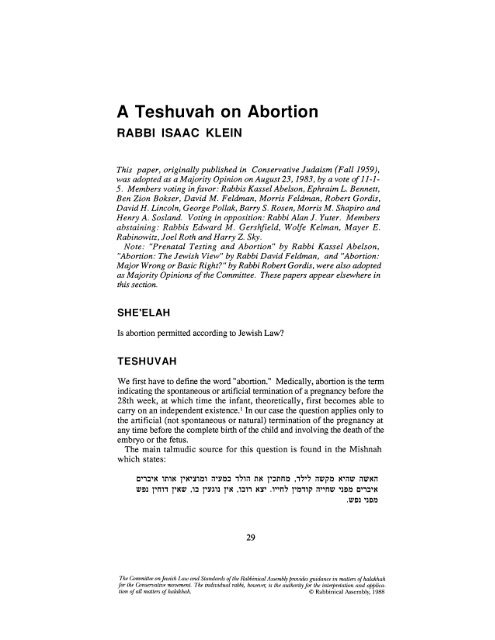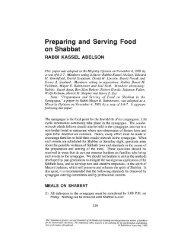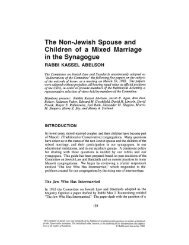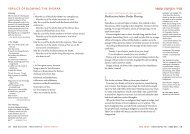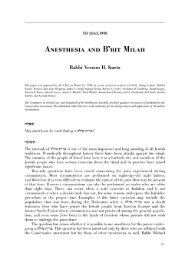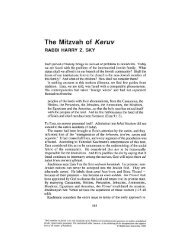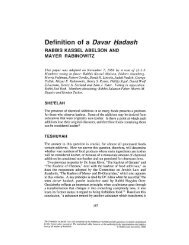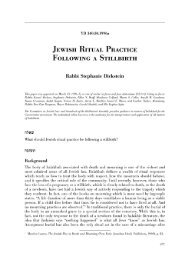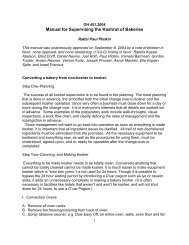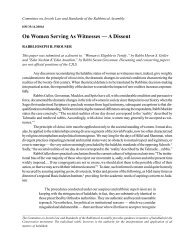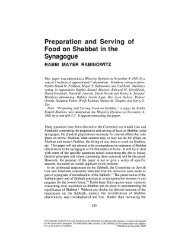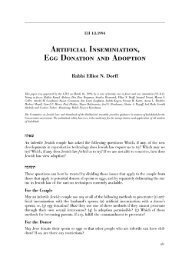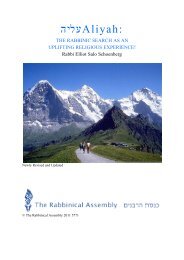A Teshuvah on Abortion - The Rabbinical Assembly
A Teshuvah on Abortion - The Rabbinical Assembly
A Teshuvah on Abortion - The Rabbinical Assembly
You also want an ePaper? Increase the reach of your titles
YUMPU automatically turns print PDFs into web optimized ePapers that Google loves.
A <str<strong>on</strong>g>Teshuvah</str<strong>on</strong>g> <strong>on</strong> Aborti<strong>on</strong><br />
5, 1902 is: No, it (aborti<strong>on</strong>) is not lawful. Such a removal of the fetus is a<br />
direct killing of the fetus and is forbidden.<br />
Afatwa of the Grand Mufti of January 25, 1937, states that therapeutic<br />
aborti<strong>on</strong>s are absolutely forbidden after the embryo has "quickened."<br />
Medical science c<strong>on</strong>siders the fetus a living thing from the moment the<br />
ovum is fertilized. 3<br />
Actually, being a living thing and being a separate entity are two separate<br />
matters. Even if it is a living thing we can say that the fetus is pars viscera<br />
matris or to use the talmudic expressi<strong>on</strong>, ubar yerekh immo hu. <strong>The</strong><br />
fetus is, thus, accounted as the loin of its mother. When aborti<strong>on</strong> is<br />
therapeutic there can be no objecti<strong>on</strong> to it because, as in any surgery, we<br />
sacrifice the part for the whole.<br />
This is the attitude the Rabbis have taken. Aborti<strong>on</strong> is forbidden.<br />
Though it is not c<strong>on</strong>sidered murder, it does mean the destructi<strong>on</strong> of<br />
potential life. 4 If, however, the purpose is therapeutic, this objecti<strong>on</strong> is<br />
removed. I have chosen a number of resp<strong>on</strong>sa dealing with the questi<strong>on</strong>.<br />
Rabbi Yair Hayyim Bachrach (1639-1702), the author of Resp<strong>on</strong>sa<br />
lfavvot Ya'ir, had this strange case. A married woman committed adultery<br />
and became pregnant. She had pangs of remorse and wanted to do<br />
penance. She asked whether she could swallow a drug in order to get rid<br />
of the "evil fruit" in her womb. In answer, Rabbi Bachrach made it clear<br />
immediately that the questi<strong>on</strong> of the permissibility of aborti<strong>on</strong> had nothing<br />
to do with the legitimacy of the child to be born. <strong>The</strong> <strong>on</strong>ly questi<strong>on</strong><br />
involved was whether aborti<strong>on</strong> is accounted as taking a life or not. Rabbi<br />
Bachrach drew distincti<strong>on</strong>s between the various stages of the development<br />
of the fetus, i.e., forty days after c<strong>on</strong>cepti<strong>on</strong>, three m<strong>on</strong>ths after<br />
c<strong>on</strong>cepti<strong>on</strong>. <strong>The</strong>n he c<strong>on</strong>cluded that it might be theoretically permitted at<br />
the early stages of the pregnancy, but we do not do so because of the<br />
custom adopted both by the Jewish and the general community against<br />
immorality.<br />
Rabbi Meir Eisenstadt (1670-1744), in his Panim Me'irot, asked the<br />
following questi<strong>on</strong>: If a woman has difficulty in giving birth because the<br />
child came out feet first, is it permitted to cut up the child limb by limb in<br />
order to save the mother? This seems to be the very questi<strong>on</strong> explicitly<br />
answered in the Mishnah. <strong>The</strong> <strong>on</strong>ly problem that is introduced is a<br />
discrepancy between the Mishnah and Maim<strong>on</strong>ides. Whereas the Mishnah<br />
states that if the greater part of the child has come out of the mother's<br />
body, we do not take the life of the child in order to save the mother,<br />
Maim<strong>on</strong>ides says that if the head of the child or the majority thereof came<br />
out first, it is c<strong>on</strong>sidered as born and we do not take its life in order to save<br />
the mother.<br />
<strong>The</strong> commentators tried to resolve this c<strong>on</strong>tradicti<strong>on</strong> by saying that<br />
33
Proceedings of the Committee <strong>on</strong> Jewish Law and Standards I 1980 -1985<br />
extrusi<strong>on</strong> of the head or the major part thereof, or, in cases when the head<br />
came last, the extrusi<strong>on</strong> of the majority of the body, c<strong>on</strong>stitutes birth. <strong>The</strong><br />
author then poses the questi<strong>on</strong>: If at this stage death could result to both if<br />
we let nature take its course, is it still forbidden to take the life of the child<br />
in order to save the mother? He leaves the questi<strong>on</strong> unanswered. 5<br />
Rabbi Eliezer Deutsch (1850-1916), the author of Resp<strong>on</strong>sa Peri<br />
Hasadeh, treats the following problem: A woman who had been pregnant a<br />
few weeks began to spit blood. Expert physicians insisted that she take a<br />
drug in order to induce a miscarriage for, should she wait, it would not<br />
<strong>on</strong>ly become necessary to take out the child by cutting it up, it would also<br />
endanger the life of the mother; if they acted immediately, it would be<br />
possible to bring forth the child with a drug. Is it permissible to do so?<br />
Rabbi Deutsch answered that in this case it is certainly permitted. He<br />
made a distincti<strong>on</strong> between the various stages in the development of the<br />
fetus, gufa abarina ("a separate body"), ne'ekar havlad ("the fetus has<br />
become detached"), between the use of drugs and the use of surgery, and<br />
between another pers<strong>on</strong> doing it or the woman herself. <strong>The</strong> c<strong>on</strong>clusi<strong>on</strong><br />
was that it is permitted in this case for three reas<strong>on</strong>s: (a) Before three<br />
m<strong>on</strong>ths after the c<strong>on</strong>cepti<strong>on</strong> there is not even a fetus; (b) <strong>The</strong>re was no overt<br />
act involved in this case, i.e., surgery; and (c) <strong>The</strong> woman herself was<br />
doing it and it is thus an act of self-preservati<strong>on</strong>.<br />
In current literature I found a resp<strong>on</strong>sum dated 5709- I, lfayyei Sarah by<br />
Rabbi Yitzhak Oelbaum of Czechoslovakia, now of Canada. This is the<br />
questi<strong>on</strong>: A woman had a weak child. According to the doctors, it would<br />
not live unless it was breast fed by the mother. <strong>The</strong> mother had been<br />
pregnant for four weeks and had felt a change in her milk. Could she<br />
destroy the child she was carrying by means of an injecti<strong>on</strong>, she inquired,<br />
in order to save the child she was nursing?<br />
<strong>The</strong> author first of all discussed the reliability of doctors in these matters,<br />
claiming that they sometimes exaggerate, and whether a proper formula for<br />
bottle-feeding could be substituted. He c<strong>on</strong>cluded that if there was expert<br />
evidence that danger might result if the aborti<strong>on</strong> was not performed, then it<br />
is permitted.<br />
In this resp<strong>on</strong>sum a new issue is introduced. Until now we have spoken<br />
of danger to the mother. Here there is no danger to the mother, but rather<br />
to another child. This opens new possibilities which we shall not pursue<br />
here.<br />
An even more recent resp<strong>on</strong>sum <strong>on</strong> the subject is by Rabbi Gedaliah<br />
Felder of Tor<strong>on</strong>to, published in Kol Torah (Heshvan 5719), a rabbinic<br />
periodical published in Jerusalem. Here the questi<strong>on</strong> is as follows: A<br />
pregnant woman was afflicted with cancer of the lungs. <strong>The</strong> doctors said<br />
that if a premature birth was not effected, the cancer would spread faster<br />
and hasten her death. Is it permissible to have an aborti<strong>on</strong> where the<br />
34
A <str<strong>on</strong>g>Teshuvah</str<strong>on</strong>g> <strong>on</strong> Aborti<strong>on</strong><br />
mother is saved <strong>on</strong>ly temporarily?<br />
Before we sum up, it would not be out of place to bring in a comment<br />
from the medical professi<strong>on</strong>. This was called to my attenti<strong>on</strong> by Dr. Hiram<br />
Yellen, a most prominent obstetrician of the City of Buffalo:<br />
<strong>The</strong>re is abundant evidence that the frequency of criminal inducti<strong>on</strong> of<br />
aborti<strong>on</strong> is increasing at an alarming rate, although accurate statistics<br />
cannot be obtained. Numerous reas<strong>on</strong>s may be advanced for this<br />
deplorable situati<strong>on</strong>, the most probable being: (1) Twentieth-century<br />
standards of living have made children an ec<strong>on</strong>omic liability for a large<br />
percentage of the populati<strong>on</strong>. This may be c<strong>on</strong>trasted with more<br />
primitive rural c<strong>on</strong>diti<strong>on</strong>s where a large family was c<strong>on</strong>sidered an<br />
ec<strong>on</strong>omic asset; (2) As a by-product of the women's freedom<br />
movement, a very large number of women have come to believe that<br />
pregnancy should be regulated by their pers<strong>on</strong>al desires; and (3) <strong>The</strong><br />
present-day lack of religious feeling and the wide teaching that<br />
pregnancy may be c<strong>on</strong>trolled have c<strong>on</strong>tributed to a lowering of moral<br />
standards am<strong>on</strong>g women, with a resulting increase in the number of<br />
undesired pregnancies .... 6<br />
Our c<strong>on</strong>clusi<strong>on</strong>, therefore, must be that aborti<strong>on</strong> is morally wr<strong>on</strong>g. It<br />
should be permitted <strong>on</strong>ly for therapeutic reas<strong>on</strong>s.<br />
NOTES<br />
1. Titus and Wils<strong>on</strong>, <strong>The</strong> Management of Obstetric Difficulties (New<br />
York, 1955), p. 210.<br />
2. See Tosefot R. Akiva Eiger <strong>on</strong> the Mishnah in Ohalot, and ljiddushei<br />
R.ljayyim Halevi ad Zoe. and comments in some of the resp<strong>on</strong>sa that deal<br />
with this questi<strong>on</strong>.<br />
3. See Obstetrics, Joseph B. De Lee, 4th Editi<strong>on</strong>, p. 274.<br />
4. See Tosafot, ljullin 33a, s.v., EIJadAkum)<br />
5. See, however, Melammed leHo'il v. 2, resp<strong>on</strong>sum 69.<br />
6. Carl Henry Davis, Gynecology and Obstetrics (1937), Ch. X, p. 1.<br />
35


